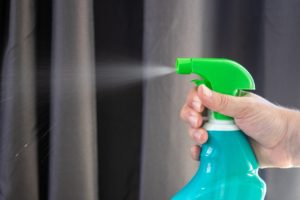All businesses have a similar goal — to earn a profit while keeping staff and customers comfortable and safe. During the coronavirus pandemic, businesses must adapt quickly so that they can open and operate safely again. However, very few people have received the right training in how to address issues presented by the pandemic. To offer support while businesses prepare to open, Local Government and Public Health England have issued guidance that covers almost every conceivable situation.
 Here, Dr. Neal Langerman Ph.D., a chemist with over 40 years’ industry experience and a freelance writer at Kolabtree, a freelance platform for scientists, explores how businesses can fill this gap in guidance.
Here, Dr. Neal Langerman Ph.D., a chemist with over 40 years’ industry experience and a freelance writer at Kolabtree, a freelance platform for scientists, explores how businesses can fill this gap in guidance.
All guidance includes information on sanitising and disinfecting the workplace and frequent hand washing to improve hand hygiene of customers and staff. However, few bodies offer guidance on selecting and using the correct disinfecting chemicals and methods or what regulatory framework businesses should follow.
Businesses are currently doing what is required to keep staff and the public safe in as efficient a manner as possible. This includes efficient sanitising and disinfecting techniques to limit the spread of the virus. While these two terms have different definitions, the nuanced differences are irrelevant to operating a business. For clarity, this article will use the word “sanitising” (or its derivatives) to mean both sanitising and disinfecting and the term “employees” will refer to both employees and customers.
SARS-CoV-2, the virus that causes COVID-19 is spread as a bio-aerosol. Depending on the mechanism of generation – breathing, talking, cough, sneezing, etc – the bio-aerosols settle out of the air column in less than two metres and in 15 minutes. While reports exist that claim exceptions to these figures, they provide a good frame of reference for creating a safe business workspace.
While the virus is quite fragile, reports suggest that it can persist on hard surfaces, both porous and non-porous, from minutes to hours, increasing the opportunity for it to transfer from hand to body and therefore increase the risk of infection. However, the lipids that coat the genetic material of the virus is easy to disrupt, so sanitising surfaces can easily kill the virus. Businesses must select the right sanitising product, understand where, how and how often to apply the product, and how often employees need to wash their hands.
To support business operators and help them understand sanitising requirements, Public Health England has published guidance for Cleaning and Disinfecting Public Spaces. Cleaning an area with hot, soapy water and normal household disinfectant can reduce the level of virus on the surface and reduce the risk of passing any infection. Implementing a regular janitorial program to clean all areas, remove waste and restocking personal protective equipment (PPE) such as face masks, can also reduce infection.
High contact surfaces

Businesses should also take care to regularly sanitise and disinfect high contact surfaces, such as door handles, counter tops and switches, by using agents approved by the Health & Safety Executive (HSE). If possible, they can reduce the number of high contact areas by using self-opening doors or imposing controls to stop contact with counter tops. Outdoor surfaces, such as sidewalks or railings, will not need sanitising agents — routine cleaning with hot water and soap is adequate.
Employees and customers will touch some high contact surfaces frequently and routine sanitising is required to reduce the risk of infection. These surfaces are items such as:
- Tables;
- Doorknobs;
- Keyboards;
- Toilets;
- Light switches;
- Countertops;
- Handles;
- Desks Phones;
- Faucets and sinks;
- Gas pump handles;
- Touch screens;
- ATM machines and many more.
Cleaning teams should perform routine cleaning procedures at least once per shift or once daily and depending on the occupancy of the space, sanitise high contact areas more frequently. For example, businesses can provide an aerosol sanitising spray in a public bathroom and request that each person uses the spray on all surfaces as they leave the facility. A larger public bathroom may also require regular sanitisation from a cleaner to further reduce risk of infection.
Regular hand washing is one of the easiest and most effective methods of reducing infection risk. Employees should wash their hands when arriving and leaving work, as well as several times during a shift. Hand washing is particularly important because employees may be handling money or items from customers and touching many surfaces.
All employees should follow guidance to wash hands with soap and water for 20 seconds and dry them thoroughly. If washing hands is not always possible, businesses should provide hand sanitiser that contains at least 60 per cent alcohol. Hand sanitisers can also contain glycol to reduce skin irritation when regularly using these products.
The right product
 There are many cleaning products on the market, so employers should select a sanitiser based on effectiveness and safety. The List N: Disinfectants for Use Against SARS-CoV-2 (COVID-19) from the U.S. Environmental Protection Agency (EPA) offers guidance and UK employees can use it as a starting point to find equivalent products in the UK.
There are many cleaning products on the market, so employers should select a sanitiser based on effectiveness and safety. The List N: Disinfectants for Use Against SARS-CoV-2 (COVID-19) from the U.S. Environmental Protection Agency (EPA) offers guidance and UK employees can use it as a starting point to find equivalent products in the UK.
Products containing bleach (sodium hypochlorite) usually have the shortest contact time. These products are often irritants, so cleaners should use gloves and properly handle the product to stop skin irritation. They should also keep bleach-based products from those that contain acids to prevent mixing them and releasing toxic gases.
Alcohol-based cleaning products made from either ethyl or isopropyl alcohol must contain alcohol over 65 per cent to be effective. These products often contain a second agent, such as hydrogen peroxide, to improve their efficiency. They are also flammable, so cleaners should be careful when handling such fluids.
Businesses that use large volumes of hand sanitiser should also be careful when handling the bottles because of flammability. Products containing quaternary ammonium (“quats”) are effective but require longer contact times. They tend to be less harmful to the skin and usually are not flammable.
If a business uses a cleaning service, it should contact them and review the sanitising agents they use. They can obtain a Safety Data Sheet (SDS) to verify the chemical composition and review the safety information of the products they carry.
Surface cleaning methods depend on the size of the surface — you can effectively clean most with a clean cloth and consumer-sized aerosol spray cleaners. Businesses should prevent using larger aerosols or sprays and only allow a cleaning service to use them because these products require training for proper handling. The HSE Control of Substances Hazardous to Health (COSHH) regulations require employers to control hazardous substances, such as these cleaning agents, to protect employees.
An employer is required to:
- Provide an SDS for each product;
- Keep the product in its original container or a labelled day-use container;
- Train all employees about the hazards of a product and how to protect themselves;
- Document all training in hazardous substances;
- Follow appropriate fire prevention procedures if a fire hazard exists due to the use of cleaning substances.
Businesses should remember that if an employee becomes ill with COVID-19 they must report the illness in accordance with the HSE’s recordkeeping requirements. Employers are held responsible for recording and or reporting illness and injury in a timely manner as mandated by the HSE. This requirement does not apply to customers that become ill.
Employers can keep sanitised workspaces and keep employees safe without compromising on productivity. By developing a clear plan to keep a clean environment when re-opening and operating, businesses can make sure they can keep employees and customers safe. Businesses should also review the plan regularly and keep it flexible so that they can adapt to any changes.
Approaches to managing the risks associated Musculoskeletal disorders
In this episode of the Safety & Health Podcast, we hear from Matt Birtles, Principal Ergonomics Consultant at HSE’s Science and Research Centre, about the different approaches to managing the risks associated with Musculoskeletal disorders.
Matt, an ergonomics and human factors expert, shares his thoughts on why MSDs are important, the various prevalent rates across the UK, what you can do within your own organisation and the Risk Management process surrounding MSD’s.

 Here, Dr. Neal Langerman Ph.D., a chemist with over 40 years’ industry experience and a freelance writer at Kolabtree, a freelance platform for scientists, explores how businesses can fill this gap in guidance.
Here, Dr. Neal Langerman Ph.D., a chemist with over 40 years’ industry experience and a freelance writer at Kolabtree, a freelance platform for scientists, explores how businesses can fill this gap in guidance. 
 There are many cleaning products on the market, so employers should select a sanitiser based on effectiveness and safety. The List N:
There are many cleaning products on the market, so employers should select a sanitiser based on effectiveness and safety. The List N: 
Would using Antimicrobial Material Covers on desks & surfaces help?
I agree. Fabric masks are recommended to prevent onward transmission in the general population in public areas, particularly where distancing is not possible, and in areas of community transmission.